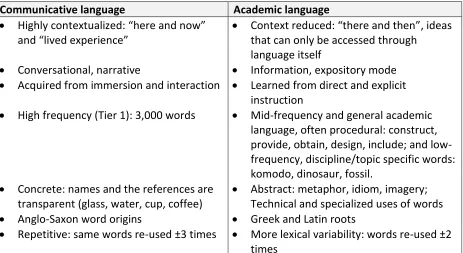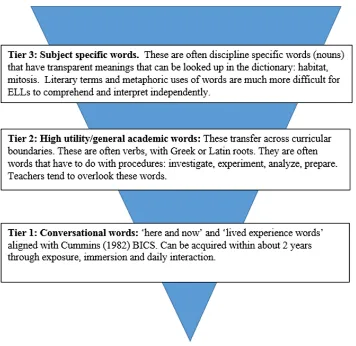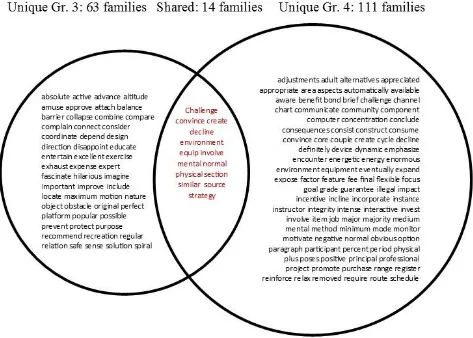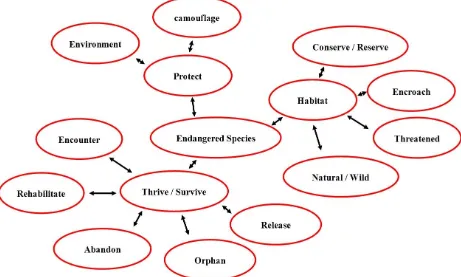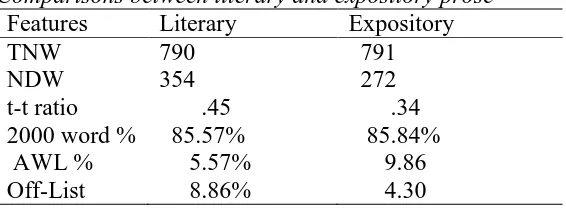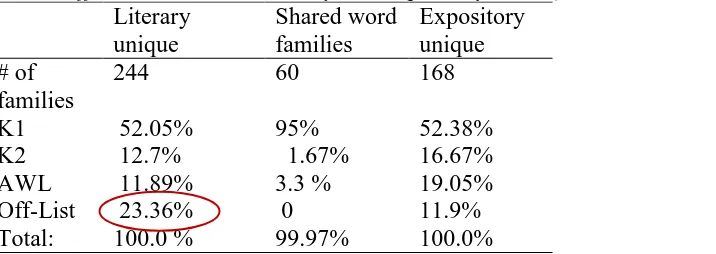Academic Language in K-12: What Is It, How Is It Learned, and How Can We Measure It?
Hetty Roessingh University of Calgary
Abstract
Using Beck, McKeown and Kucan’s (2002) three-tiered model as a general framework for vocabulary, this article sheds light on the construct of academic vocabulary and how it might be measured. Using illustrative writing samples of student work of different genres and drawing on corpus based studies, I highlight the distinction between general, high utility academic
vocabulary visible in expository mode (Tier 2), and narrative vocabulary (Tier 1) on the one hand; and general, high utility academic vocabulary and literary vocabulary associated with English Language Arts literature-based curriculum (Tier 3). Tier 2 words have consistently correlated with academic achievement across disciplinary boundaries, especially at post-secondary levels. Suggestions are made for policy reform, curriculum, and assessment
approaches that will afford more equitable access to post-secondary programs of study for the growing numbers of English language learners across Canada, including in provinces such as Alberta and British Columbia.
Introduction
The research community is increasingly cognizant of the key role of vocabulary in academic literacy development among students in the K–12 school system (Beck, McKeown & Kucan, 2002; Cummins & Mann, 2007; Ranney, 2012; Schleppegrell, 2012). There is growing consensus among scholars related to the construct of academic vocabulary and pedagogical considerations (DiCerbo, Anstrom, Baker & Rivera, 2014). Approaches to assessment are less well developed especially in relation to English language learners (ELLs).
This article aims to contribute to the discussion on both the meaning and assessment of academic vocabulary. This is a timely contribution, given Canada’s shifting demographic landscape to include increasing numbers of Canadian-born children of immigrants whose first language is not English. They represent between 25–50% of the general school-going population in large, urban school jurisdictions in Vancouver (Skelton, 2014), Toronto and Calgary. English language learners (ELLs) are not distributed equally throughout school jurisdictions, and many are not identified for funding purposes (British Columbia Teachers’ Federation, 2012). Based on British Columbia (BC) Ministry of Education data, out of approximately 550 schools in the Metro Vancouver area, Skelton (2014) reports 65 schools—primarily in Richmond, Surrey, and Vancouver—where more than half of the students are ELLs. Gillis (2016), citing data from the Early Development Instrument (EDI, 2015), observes that many children from high SES
exacerbate the linguistic divide starting early in the educational trajectory and accelerating over time.
Increasing numbers of ELLs, estimated as high as 45% in the admissions data at one Canadian university (Roessingh & Douglas, 2012), underscore the urgency to address concerns related to their preparedness for engaging with the demands of post-secondary studies. There is a need for pragmatic approaches for teaching, tracking, and testing the growth of academic
vocabulary use over time, and further to consider policy implications related to thresholds required for educational success at all levels in the K–12 system and beyond.
What is Academic Vocabulary?
In broad strokes, academic vocabulary pertains to the language of school and the demands for engaging in the reading and writing tasks associated with curriculum. With each advancing year of participation in the educational system these demands accelerate—both in their quantity and complexity. Figure 1 below summarizes the salient differences between communicative and academic modes of language use.
Communicative language Academic language
Highly contextualized: “here and now” and “lived experience”
Conversational, narrative
Acquired from immersion and interaction
High frequency (Tier 1): 3,000 words
Concrete: names and the references are transparent (glass, water, cup, coffee)
Anglo-Saxon word origins
Repetitive: same words re-used ±3 times
Context reduced: “there and then”, ideas that can only be accessed through
language itself
Information, expository mode
Learned from direct and explicit instruction
Mid-frequency and general academic language, often procedural: construct, provide, obtain, design, include; and low- frequency, discipline/topic specific words: komodo, dinosaur, fossil.
Abstract: metaphor, idiom, imagery; Technical and specialized uses of words
Greek and Latin roots
More lexical variability: words re-used ±2 times
Figure 1. Differences between communicative and academic language
Cummins coined the terms Basic Interpersonal Communication Skills (BICS) and
Cognitive Academic Language Proficiency (CALP) to describe the interdependency of linguistic – cognitive development over time. Many K–12 practitioners will be familiar with Cummins’ model (1981). In brief, Cummins posits a continuum of language learning along two axis: from cognitively undemanding to cognitively demanding along the vertical axis and from context embedded to context reduced along the horizontal axis. BICS level language comprises the two quadrants cognitively undemanding/context embedded language and cognitively
experience” vocabulary needed to navigate and negotiate our daily interactions and basic literacy needs. As language becomes more cognitively demanding and context reduced, learners must avail themselves of language itself to make meaning. Often, these meanings are framed by way of metaphor, adding another level of complexity to this language. Roessingh (2006) elaborates on Cummins’ model with further illustrative information that will be helpful to a practitioner audience.
Beck, McKeown and Kucan (2002) advance a three tiered model for understanding communicative versus academic language. It differs from Cummins’ BICS-CALP model in making the distinction between general academic vocabulary and discipline specific academic vocabulary. The model is illustrated in Figure 2, below.
Figure 2. Three tiered model of vocabulary (Beck, McKeown, & Kucan, 2002)
Tier 1 words correspond to Cummins’ conceptualization of BICS comprising perhaps 2,000–3,000 high frequency word families needed for daily interaction, though Beck, McKeown and Kucan (2002) suggest a threshold of 8,000 word families. These word families form the important foundation needed to build further meaning in the Tier 2 “next words to know.” The Tier 2 words are the high utility or general academic words that travel across curricular
families from analyzing a large corpus of university textbooks and academic writing. However, many of these words are not particularly difficult, and appear in the corpus of academic words young students in Grade 3 use in their writing in response to an expository prompt (Roessingh, Douglas & Wojtalewicz, 2016). There is rapid growth in this vocabulary in the Grade 4 year (Wojtalewicz, 2016). Figure 3 below illustrates this growth, taken from the writing of the same group of young learners over one year in the studies cited above. Beck, McKeown and Kucan further suggest an additional 7,000 Tier 2 word families, a figure that together with the Tier 1 words noted earlier, would indicate a Grade 9 reading age of approximately 15,000 word families or 50,000 words.
Figure 3. Growth of academic words from Grade 3 to Grade 4
suggests, tens of thousands of these words, estimated at 85,000 words or 18,000 word families, are needed to access advanced textbook information.
Among children, it is important to note that there is a developmental aspect to the arrival of academic words in their lexical repertoire. The age of 7–9 marks, in Piagetian terms, the point at which children become structured thinkers, and are able to name and describe objects,
articulate similarities and differences, categorize and classify, and understand the properties of objects according to their key features such as size, shape, speed, and colour (Isaacs, 1974). Monkey bars, slides and swings can now be described as playground equipment, for example. Increasing use of words with Greek and Latin roots in particular are now used to talk about procedures such as construct vs. build, design vs. draw, and create vs. make (Roessingh & Elgie, 2015). Increasingly, students are expected to understand specialized uses of common words such as energy or work; and to learn content-curriculum specific vocabulary such as habitat or
species.
A second developmental milestone is realized around age 15, as students increasingly are able to avail themselves of metaphor and imagery to access abstract ideas. As noted earlier, such uses of vocabulary may be particularly difficult for ELLs since they are often culturally
constrained: a dance or a journey to refer to the aging process versus the idea of ripening fruit in Asian culture as a metaphor for the passage of time and aging. Idioms and proverbs such as “beauty is only skin deep,” or “never judge a book by its cover” are often equally difficult for linguistic and culturally diverse learners to “unpack.” Pavlov (2015) found that while ELLs are represented across the full range of scores on Grade 12 provincially mandated tests of reading comprehension involving literary texts, on average they score less well than their native English speaking (NS) classmates largely related to the use of this type of vocabulary and lexical
bundles—strings of words that must be interpreted as a whole, such as idioms. The ability to engage with text at an aesthetic, contemplative level (Rosenblatt, 1985) involves the ability to evoke images and associations especially through the use of metaphor, a task that will be very difficult for a growing demographic of ELLs present in our K–12 schools.
How is Academic Vocabulary Learned?
As noted earlier, BICS type language associated with conversational discourse can be acquired through exposure and opportunities to interact with NS or more competent users of English, in contexts that require negotiating meaning and problem solving, for example. The vocabulary involved is high frequency, cognitively undemanding, and context embedded, thus providing support for getting at the meaning of these words.
Young learners who already know these words will often have learned them from their parents through engaged, elaborative and collaborative talk and the co-construction of meaning. Torr and Scott (2006) observe the storybook reading behaviours of high socio-economic status (SES) mothers include introducing as many as 34 words beyond the words “on the page” through elaborated, extended talk. From my work with young students, I have been apprised of many different opportunities and life experiences made available to them that afford access to
sophisticated input (Roessingh & Elgie, 2009). Family trips to the zoo, the science centre, travel (to Paris), hiking with a parent who points out interesting indigenous flowers and grasses, shadowing father at his place of work in the research lab, and even the innocuous task of buying a new toaster presents an opportunity to learn a new word. Hence, words such as aquarium, telescope, microscope, cheetah, monuments, appliance, and thistle are in the receptive, oral repertoire of these youngsters, and, later when these words are elicited either from a picture prompt or encountered in print, they can readily produce or comprehend them (Biemiller, 2003b). Sometimes a single exposure was sufficient for the word to register with the youngster: an insatiable interest and curiosity about language and the names of things, a strong memory capacity, and the ability to retain connections and context information were reported to me by these young learners.
Over time, many researchers report a widening gap in the vocabulary knowledge between advantaged learners and those who are linguistically vulnerable for reasons of SES, or language minority status, although, as noted earlier, advantaged SES may not in itself ensure access to rich English language learning opportunities. Targeting instruction would benefit from a strategic approach to knowing which words, how many, and when. Corpus based studies and the creation of developmental academic word lists would be helpful in providing teachers more precise information on where to begin teaching the words children need to know. A scatter shot approach to addressing the 18,000 word families an academically oriented 18 year old high school graduate seeking university admission is estimated to need in order to access university course materials is an overwhelming task for any school teacher. Targeting the big bang for the buck words involves not only frequency, but other considerations such as its position in a thematic field that would naturally connect to other words readily learned through incidental exposure as well as its collocations. Figure 4 on the next page illustrates this idea.
Measuring Academic Vocabulary in Kindergarten to Grade 12
task of My Incredible Journey, the standard setting sample paper, comprising 354 words, demonstrates overwhelming use of high frequency Tier 1 vocabulary. Two words, security and finally, are drawn from the Academic Word List (Coxhead, 2000) and are considered Tier 2 words.
Figure 4. Words in a thematic field.
The University of British Columbia (UBC), like others across Canada, requires all prospective students to demonstrate English-language competency prior to admission. Various options are available to fulfill this requirement; however, for most BC high school graduates seeking admission to UBC, a final Grade in Grade 11 or Grade 12 English, including the
provincial examination is taken as a proxy for English-language competency. A score of 70% or better is required on the provincial examination portion of Grade 12 English or the equivalent (UBC, n.d.). However, for ELLs, including the Canadian born children of immigrants, there may be challenges to reaching this threshold (Roessingh & Douglas, 2011). Recall that literary
language is constrained by culture, and many ELLs find themselves “on the outside”—frustrated in their attempts to make meaning of words used metaphorically or figuratively. In addition, students applying to UBC’s Vancouver campus who do not achieve a grade of 75% in Grade 12 English or an approved equivalent standard are required to demonstrate the first year English course entry requirement (UBC Department of English, n.d.). Students who do not meet this requirement are most likely to fulfill the English language competency requirement by way of the Language Proficiency Index (LPI) (LPI, 2016), a measure of academic writing that includes an expository essay of 300 – 400 words.
(1997), referred to this threshold as the lexical bar. This is generally achieved through expository modes of writing. Neither narrative nor literary responses fulfill the requirements: the former overwhelmingly elicits Tier 1 words; the latter elicits the types of literary language that is bounded by the English language arts curriculum.
The figures below illuminate these points. In the first example (Figure 5), a Grade 3 student writes a narrative entitled Birds Galore. The student is tasked with developing a story in response to a picture prompt showing a young boy in a bird costume intently gazing into a nest of birds’ eggs, one of them newly hatched. There is no sign of the mother. The same student writes an expository text, this time explaining her ideas on how to use the empty space behind the school yard. Both texts are digitized, corrected for spelling and submitted to vocabulary profiling tools available in the public domain at www.lextutor.ca/vp/kids (Cobb, 2016a).
Vocabulary profiles are generated for each sample of approximately equal length (250 words) to glean insights into various indices of lexical variability that reflect on the productive demands of each genre of writing.
Table 1 summarizes some of the salient differences between narrative and expository prose written by the same young student (both samples assessed as “excellent” writing) who scored on the 95th percentile on a vocabulary measure.
The data include the total number of words or tokens (TNW), the number of different words (NDW), the type-token ratio (a ratio of the NDW to TNW), the percent coverage at the 1,000 word frequency threshold (i.e. Level 4, with each of the 10 levels accounting for 250 word families), and the number of Off-List words, reflecting the vocabulary “reach” beyond the 2,500 word families represented in the reference corpus of children’s oral language at age 5–7.
Table 1
Differences between narrative and expository prose Features: Birds Galore Empty space
TNW 251 249
NDW 138 136
t – t ratio .55 .55
1000 word % 88.84 79.11
Off- List % 4.78 7.63
Examples of O-L and AWL
Encounter, opposite, fury, rage, permission
Aid, amount, equipment, include, locate, maximum, public, supervisor
In brief, the data in Table 1 reflect far greater use of the high frequency words at the 1,000 word threshold in narrative prose (88.84%) versus expository (79.11%). Access to low frequency and academic words as a percentage of the total words generated in the expository text is greater than in the narrative (7.63% vs 4.78%). A comparison of words in the narrative versus expository writing using the Text Lex Compare feature on the www.lextutor.ca website (Cobb, 2016b) reveals the use of 86 word families unique to expository writing, 53 of them (40%) beyond the 1,000 word threshold that is accessible to most young writers at Grade 3. This represents a sizable gap and qualitative difference in vocabulary use between narrative and expository prose, making a compelling case for the use of expository prompts to identify young writers who may be linguistically vulnerable and who might benefit from targeted vocabulary instruction (Roessingh, 2012).
Figure 6. Literary vs. Expository
Table 2 below provides some points of comparison that reflect on the question of academic vocabulary. These data were taken from vocabulary profiles generated on the VP Classic tool available on www.lextutor.ca (Cobb, 2016a). Data beyond the 2,000 word frequency threshold and the Academic Word list (AWL) are reported. Coxhead (2000) developed the AWL from a corpus a university level reading materials. The AWL consists of 570 head words (word families) beyond the 2,000 word threshold in English. They are organized into 10 sub-lists by frequency, and offer a good resource for practitioners to consider in their instructional
planning. Many of these words are accessible to young students in elementary school. The word web in Figure 4, for example, aligns with content in science curriculum that is often addressed around Grade 4.
The first text, a critical response to the prompt, “The struggle to restore honor and certainty in William Shakespeare’s Hamlet” and the second—the “empty space” prompt (the same as that given to the Grade 3 student above) are both assessed at the standard of excellence. Table 2
Comparisons between literary and expository prose Features Literary Expository
TNW 790 791
NDW 354 272
t-t ratio .45 .34 2000 word % 85.57% 85.84% AWL % 5.57% 9.86 Off-List 8.86% 4.30
In the play Hamlet by William Shakespeare, the eponymous hero struggles to restore honor and certainty to the corrupt kingdom of Denmark. For the purposes of this essay, honor will be defined as honesty and integrity, and certainty will be defined as justified, true belief. Hamlet struggles to restore honor and certainty in three ways: through thought, which only leads him to further doubt, through manipulation, which Hamlet finds difficult due to his inherent honesty, and through force, which Hamlet turns to out of despair. These three strategies slowly transform Hamlet from a fair and gentle prince to a source of corruption that equals his uncle, the ‘treacherous, lecherous, damned villain.’
The space provided by the large undeveloped area in the schoolyard provides a variety of excellent opportunities for the creation of numerous projects that are practical and enjoyable for both
Controlled for length, both texts reflect similar coverage of 85% at the 2000 word threshold. The pattern for the AWL and the Off-List words are in stark contrast. A Text Lex Compare of the two texts revealed these differences.
Table 3
Lexical differences between Literary and Expository Texts (Total = 472 word families) Literary
unique
Shared word families
Expository unique # of
families
244 60 168
K1 52.05% 95% 52.38%
K2 12.7% 1.67% 16.67%
AWL 11.89% 3.3 % 19.05%
Off-List 23.36% 0 11.9%
Total: 100.0 % 99.97% 100.0%
These two texts have little in common: they share just 60 word families (approximately 12.7% of the 472 word families in total). Perhaps the single most striking feature of literary text is the heavy use of Off-List words. Again, these are overwhelmingly discipline specific, Tier 3 words : antic, avenge, betray, contempt, deceit, desperate, disposition, eponymous, feign,
lecherous, reconcile, remorse to give a few examples. The two texts share just two AWL words: furthermore and maintain. The remaining AWL words are drawn from the low frequency lists and include ambiguity, inherent, and integrity.
The expository text, on the other hand, contains a far greater percentage of AWL
(19.05%) and they appear on the high frequency sub-lists of the AWL. They are good candidates for instruction since they have high general academic utility: available, function, issue,
community, participate, contribute, option, project, and promote for example. Similarly, the Off-List words are accessible and also would seem to have high utility: engage, install, and oblige for example.
The way ahead
This article makes a pitch for addressing the needs of ELLs while maintaining the high school requirements of the ELA curriculum across Canada. Through literature study, we come to know ourselves and each other, our history, and our dreams for the future that is constantly reshaped as our demographic landscape evolves and we reinvent the Canadian identity based on values of inclusion and diversity. This project takes time and hard work. Pedagogical approaches must make this language and content more accessible through a variety of means. A major challenge will be to identify and select literary texts that are relevant and resonate with the increasing diverse learner profile of the inclusive classroom. Comprehension is not beyond the reach of most ELLs with a little mediation and explicit instruction. Delpitt (1988) makes an impassioned plea to educators to make the language of school more available to linguistically vulnerable and culturally diverse young learners. To deepen engagement with these texts to the transactional-aesthetic level suggested by Rosenblatt (1986) requires much more and is potentially not within reach of many first generation ELLs: they remain cultural spectators (as I do) and find it very difficult to live life through literature, and to bring personal life experiences to the study of literature through language. It is akin to experiencing the literature curriculum through a frosted glass window, only partially accessible—the grasp is elusive, the meaning obscured and for the most part, the words remain as they were, “on the page.” Look instead for inspiration in a sunset and grace through everyday small miracles that do not require language to touch the soul, reminding us what it means to be human.
English for academic purposes curricula have been found to make a difference in the academic outcomes at university (Crossman, 2014; Crossman & Pinchbeck, 2012). Such
programs can easily be implemented in high school to complement the ELA program, ideally in Grade 11 or early Grade 12. As well, we must begin with young learners as early as their arrival in kindergarten, and sustain involvement with academic vocabulary over the duration of the K– 12 years. Why not teach Latin for kids (Van Tassel-Baska, 1987)?
Future research can involve developing growth models for the arrival of academic words into the lexicon of young learners over time from analyzing expository writing samples from time series data, generating the “words to know,” or a developmental AWL for young learners. This would provide an excellent start point for instructional planning and in turn, enhancing achievement outcomes among linguistically vulnerable young learners, including the Canadian born children of immigrants who may not have access to academic vocabulary either at home, or, it would seem, at school.
Finally, policy initiatives could include universities awarding advance credit for an iEAP course (Crossman, 2014) taken in high school that could be accompanied by a diploma exam along the lines of BC’s LPI test. It is timely to rethink the demands of a literature based course as the gate keeper to admission to post-secondary institutions including universities, colleges, and technical programs.
potential. Canada’s quality of life depends on the ability to be competitive in a complex, connected global economy that demands increasing levels of academic literacy.
References
Academic Therapy Publications (2000). Expressive One Word Picture Vocabulary Test. Novato, CA: Author.
August, D., Carlo, M., Dressler, C., & Snow, C. (2005). The critical role of vocabulary
development for English language learners. Learning Disabilities Research and Practice, 20(1), 50-57.
Beck, I. L., McKeown, M. G., & Kucan, L. (2002). Bringing words to life: Robust vocabulary instruction. New York: Guilford.
Biemiller, A. (2003a). Vocabulary: Needed if more children are to read well. Reading Psychology, 24, 323-335.
Biemiller, A. (2003b). Oral comprehension sets the ceiling for reading comprehension. American Educator, spring, 2003.
Biemiller, A. (2012). Words for English language learners. TESL Canada Journal, 29 (Special Issue 6). 198 – 203.
British Columbia Teachers’ Federation (2012). 2012 BC education facts. Retrieved from
http://www.bctf.ca/uploadedfiles/public/publications/2012edfacts.pdf
British Columbia Ministry of Education (2016). English 12. Report to schools. Retrieved from
https://www.bced.gov.bc.ca/exams/pdfs/1606en_rt.pdf
British Columbia Ministry of Education (2016). Foundation Skills Assessment. Retrieved from
http://www2.gov.bc.ca/gov/content/education-training/k-12/teach/assessment/foundation-skills-assessment/preparing-students-fsa
Cobb, T. (2016a). VocabProfile Home. Compleat Lexical Tutor. Retrieved from
http://www.lextutor.ca/vp
Cobb, T. (2016b). Text Lex Compare. Compleat Lexical Tutor. Retrieved from
http://www.lextutor.ca/cgi-bin/tl_compare/
Corson, D. (1997). The learning and use of academic English words. Language Learning, 47, 671-718.
Coxhead, A. (2000). A new academic word list. TESOL Quarterly, 34(2), 213-238. Retrieved from http://www.jstor.org/stable/3587951
Crossman, K. (2014). Intensive English for Academic Purposes: A curriculum designed and developed for local English language learners entering university. Unpublished PhD thesis. University of Calgary.
Crossman, K. & Pinchbeck, G. (2012). An intensive Academic English course for Generation 1.5 ELLs bound for post-secondary studies: Curriculum design, development and
implementation. TESL Canada Journal, Special Issue 6, 231 – 245.
http://www.teslcanadajournal.ca/index.php/tesl/article/view/1120/939
Cummins, J. (1981). The role of primary language development in promoting educational success for language minority students. In California State Department of Education (Ed.), Schooling and language minority students: A theoretical framework (pp. 3-49). Los Angeles, CA: Evaluation, Dissemination and Assessment Center, California State
Cummins, J., & Man, E. Y.-F. (2007). Academic language: What is it and how do we acquire it? In J. Cummins & C. Davison (Eds.), International handbook of English language
teaching (Vol. 2, pp. 797–810). New York: Springer. Retrieved from
http://link.springer.com/chapter/10.1007%2F978-0-387-46301-8_53#page-1 Delpit, L. (1988). The silenced dialogue: Power and pedagogy in educating other people's
children. Harvard Educational Review, 58 (3), 280-299.
http://dx.doi.org/10.17763/haer.58.3.c43481778r528qw4
DiCerbo, P., Anstrom, K., Baker, L., & Rivera, C. (2014). A review of the literature on teaching academic language to English language learners. Journal of Educational Research, 84(3) 446 – 483. Retrieved from http://rer.sagepub.com/content/84/3/446.full.pdf+html
Douglas, S. (2010). Non-Native English Speaking Students at University: Lexical Richness and Academic Success. PhD dissertation, University of Calgary.
http://dspace.ucalgary.ca/bitstream/1880/48195/1/2010_Douglas.pdf
Duke, N.K. (2000). 3.6 minutes per day: The scarcity of informational texts in first Grade. Reading Research Quarterly, 35 (202-24).
Early Development Instrument. (2015). Early child development mapping project Alberta. Retrieved from http://www.ecmap.ca/findings-maps/calgary-edmonton-results.html
Gillis, C. (2016). Money can’t buy happy kids. Maclean’s magazine, November 7, 2016. 21-22.
http://www.macleans.ca/news/rich-vancouver-neighbourhood-proves-money-cant-buy-happy-kids/
Isaacs, N. (1974). A brief introduction to Piaget. Schocken.
Language Proficiency Index. (2016). LPI. Retrieved from https://www.lpitest.ca/
MacGinitie, W. & MacGinitie, R. (1992). Gates MacGinitie Reading Tests, 2nd Ed. Nelson Canada.
Olinghouse, N., & Wilson, J. (2013). The relationship between vocabulary and writing quality in three genres. Reading and Writing, 26(1), 45–65. Retrieved from
http://link.springer.com/article/10.1007%2Fs11145-012-9392-5#page-1
Pavlov, V. (2015). Challenges faced by English language learners on the Alberta English Language Arts 30 – 1 Reading Diploma Examination. Unpublished PhD dissertation. University of Calgary. 2015.
Pinchbeck, G. (2016). Inferencing lexical scales for monolinguals and bilinguals for vocabulary use in learner corpora. ACLA conference presentation. Calgary, AB. June, 2016. Ranney, S. (2012). Defining and teaching academic language: Developments in K-12 ESL.
Language and Linguistics Compass, 6(9), 560-574.
Roessingh, H. (2006). BICS-CALP: An introduction for some, a review for others. TESL Canada Journal, 23(2), 91-96. Retrieved from
http://teslcanadajournal.ca/index.php/tesl/article/view/57/57
Roessingh, H., & Elgie, S. (2009). Early language and literacy development among young ELL: Preliminary insights from a longitudinal study. TESL Canada Journal, 26(2), 24-45. Retrieved from http://www.teslcanadajournal.ca/index.php/tesl/article/view/413 Roessingh, H. (2012). The importance of the prompt for eliciting language samples: Insights
from research and considerations for practice. TexELT: Texas English Language Teaching, 1(1), 37-56. Retrieved from http://www.textesolv.org
Integration, 13 (3), 285-301. Retrieved from
http://www.springerlink.com/content/n62629705u6jv66q/
Roessingh, H., & Douglas, S. (2012). Educational outcomes of English language learners at university. Canadian Journal of Higher Education, 42(1), 82 – 97. Retrieved from
http://ojs.library.ubc.ca/index.php/cjhe/index
Roessingh, H.; Douglas, S., & Wojtalewicz, B. (2016). Lexical standards for expository writing at Grade 3: The transition from early literacy to academic literacy. Language and
Literacy. Retrieved from
https://ejournals.library.ualberta.ca/index.php/langandlit/article/view/24645/21011 Rosenblatt, L. (1986). The aesthetic transaction. Journal of Aesthetic Education, 20, 122-120. Schleppegrell, M. (2012). Academic language in teaching and learning. Elementary School
Journal, 112(3), 409-418. http://www.jstor.org/stable/10.1086/663297
Skelton, C. (2014). ESL students in the majority at more than 60 schools in metro Vancouver. Vancouver Sun, July 8, 2014. Retrieved from
http://www.vancouversun.com/health/students+majority+more+than+schools+Metro+Va ncouver/10005768/story.html
Stahl, S. (2003). How words are learned incrementally over multiple exposures. American Educator, 27(1), 18-19.
http://www.aft.org/pdfs/americaneducator/spring2003/AE_SPRNG.pdf#page=6 Stemach, G., & Williams, W. (1988). Word Express: The first 2500 words of spoken English.
Novato, CA. Academic Therapy Publications.
Torr, J., & Scott, C. (2006). Learning ‘special words’: Technical vocabulary in the talk of adults and preschoolers during shared reading. Journal of Early Childhood Research, 4(2), 153-167.
University of British Columbia (n.d.). English Language competency requirements. Retrieved from http://you.ubc.ca/applying-ubc/english-language-competency/
University of British Columbia Department of English. (n.d.). Frequently asked questions. Retrieved from http://english.ubc.ca/first-year-english/frequently-asked-questions-faq/#1
Van Tassel-Baska, J. (1987). The case for teaching Latin to the verbally talented. Roeper Review, 9(3), 159-161.
Wojtalewicz, B. (2016). An investigation of productive vocabulary in upper elementary: Corpus-based lexical analysis of Grade 4 learners’ expository writing. MA thesis. University of Calgary.
The BC TEAL Journal is licensed under a
Creative Commons Attribution-NonCommercial-NoDerivatives 4.0 International License.
